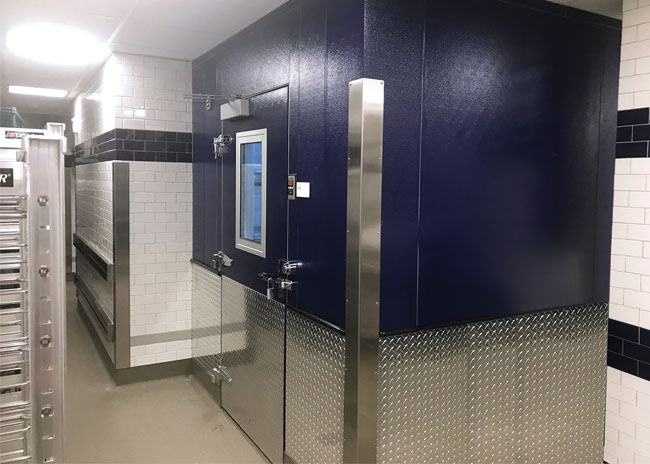Walk-in coolers and freezers are essential for foodservice and retail businesses, ensuring proper storage and preservation of food items. However, like any equipment, they can encounter problems that affect performance. Understanding and troubleshooting these issues is critical for maintaining efficiency and functionality.

Common Issues and Signs
Issues like fluctuating walk-in temperatures, frost buildup, compressor failure, and inadequate cooling are common problems with walk-in coolers and freezers. These problems can lead to food spoilage, which can lead to significant financial losses. Awareness of and addressing these common issues can help you avoid such losses.
Signs of Issues include:
- Inconsistent Temperature Readings
- Unusual Noises
- Water Leakage
- Sudden Spike in Energy Use
Unusual noises like squealing, grinding, or rattling could indicate a broken fan, damaged motor, or compressor issues. Water leakage could signal a blocked drain line or a malfunctioning defrost system. A sudden increase in energy consumption can point to dirty coils, failing compressors, or thermostat malfunctions.
Troubleshooting Tips
Warm Walk-In Cooler or Freezer
Over 85% of food safety and product loss is due to temperature issues in walk-ins. If your walk-in is running warm, consider these potential causes:
- Thermostat Problems:
- The thermostat controls the walk-in’s temperature. If it's malfunctioning, the cooler or freezer may run warmer than desired.
- To check, turn it to the lowest setting and listen for a click. If you hear it, the thermostat is working. If there's no click, the thermostat may need replacement.
- Defrost Cycle Issues:
- The defrost cycle removes ice from the evaporator coils. If it’s not working correctly, ice can accumulate and hinder cooling.
- Check the defrost timer, heater, and thermostat for signs of damage or malfunction. Call a service technician if you are unsure how to find or check.
Electronic Controllers
Electronic controller systems for walk-ins can reduce and even avoid temperature and defrost issues. These controllers are more precise, reliable, and energy-efficient than mechanical systems. They provide error codes and online data, allowing operators and service technicians to identify issues quickly. Features like demand defrost can save up to 27% on energy usage. Other features like reverse cycle defrost create additional energy savings.
Maintenance Tips
Regular maintenance is crucial for ensuring the efficient and trouble-free operation of your walk-in cooler or freezer. Component replacement is expensive and can frequently be avoided by simple maintenance. For example, replacing a refrigeration system compressor ranges from $200 to over $700, not including labor2. However, routine cleaning procedures can avoid that cost altogether.
Here are some maintenance tips:
- Cleaning:
- Clean the interior and exterior regularly with mild detergent and warm water. Avoid abrasive cleaners or sharp tools that can damage surfaces.
- Door Seals:
- Inspect door seals regularly for cracks or gaps. Damaged seals can cause temperature fluctuations and increased energy use.
- Condenser Coils:
- Remove dust and debris from condenser coils. Blocked coils can hinder proper heat exchange and overwork the compressor.
- Fan Blades:
- Check evaporator and condenser fan blades for signs of damage or wear. Replace any damaged blades promptly.
Preventing Common Problems
- Avoid Overfilling: Overcrowding can block airflow and cause temperature inconsistencies.
- Organize Properly: Keep the walk-in well-organized to allow proper air circulation and maintain a consistent temperature.
- Regularly Check Temperature Settings: Ensure they are correct, as extreme temperatures can strain components and lead to malfunctions.
Regular Inspection and Maintenance Checklist
- Door Hinges and Latches:
- Check for signs of wear or misalignment. Adjust or replace them as necessary.
- Temperature and Humidity Levels:
- Monitor interior levels with a reliable thermometer and hygrometer.
- Power Supply and Electrical Connections:
- Inspect for loose or damaged wires. Repair or replace any faulty components immediately.
- Professional Maintenance:
- Schedule regular professional maintenance to catch potential issues before they escalate.
Conclusion
By following these cleaning, maintenance, and prevention tips, you can significantly reduce the likelihood of encountering problems with your walk-in cooler or freezer, ensuring smooth operation.
For further information or service assistance, contact the RSG Technical Services team at 1-800-388-5253 or email This email address is being protected from spambots. You need JavaScript enabled to view it..
References:
- “Running a little hot and cold? Avoid the food safety danger zone,” Food Safety News, August 28, 2019.
- “Calculating the Cost of Restaurant Equipment Failures,” xtraCHEF, October 14, 2019.



